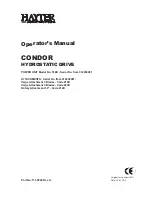
18
LPP PetRoL GeNset oPeRAtoRs' hANdbook
PRe-oPeRAtIoN CheCk
GRoUNdING
Be sure to ground (earth) the generator.
•
The ground terminal connected to the frame of the generator has been provided
for grounding purpose.
•
Be sure that the ground wire have sufficient current capacity.
(1) Ground wire diameter: 0.12 mm (0.005in) per ampere
•
The ground wire should be made of 0.1285 in dia (AWG#8) copper wire. Do not
use wire with a higher gauge number. Higher gauge numbers indicate thinner
wire, which may not provide an adequate ground path.
•
Securely fasten the end teminal of the ground wire to the ground terminal on the
generator frame. Tighten the lock nut on top of the ground wire end terminal.
The other end of the ground wire must be securely fastened to an approved
ground source. The examples given below illustrate a few of the ways in which
a good ground source may be established.
A metal underground water pipe in direct contact with the earth for at least 10
feet canbe used as a grounding source. If an underground pipe is unavailable,
an 8 foot length of pipe or rod may be used as the ground source. The pipe
should be 3/4 inch diameter or larger and the outer surface must be noncorrosive.
If a steel or iron rod is used it should be at least 5/8 inch diameter and if a
nonferrous rod is used it should be at least 1/2 inch diameter and be listed
as material for grounding. Drive the rod or pipe to a depth of 8 feet. If a rock
bottom is encountered less than 4 feet down , bury the rod or pipe in a trench.
All electrical tools and appliances operated from this generator, must be properly
grounded by use of a third wire or be "Double insulated".
















































